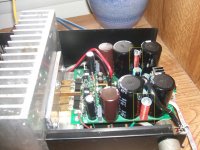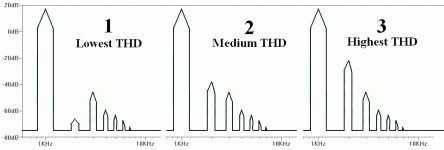I'm always shocked at how inaudible low order distortion can be. I try to get distortion as low as possible, but it's amazing how undistorted a pair of EL34 tubes wired as UL sound WITHOUT global feedback. The problem is of course the lack of damping, so you get a massive tonal shift from your speakers.
Lack of damping is just a poor way of saying current amp. If you are going to use a currnt amp, then you should build speakers that work well woth current amps (ie have a very flat (or complementary to the FR) impedance curve.
dave
Distortion? No thanks. I belive music reproduction should have as little distortion as possible. This goes for much more than just THD....allthough it sells well, THD by itself for the most part is meaningless.😛
This is why I made this amp...here. see attachment
This is why I made this amp...here. see attachment
Attachments
Our hearing produces distortion which is quite easy to perceive with a few simple tests, so it always surprises me that we know when an audio system is clean and working well. Ear distortion can be measured, and is used for testing babies' hearing, the absence of distortion signifying a possible problem.
Our hearing produces distortion which is quite easy to perceive with a few simple tests, so it always surprises me that we know when an audio system is clean and working well. Ear distortion can be measured, and is used for testing babies' hearing, the absence of distortion signifying a possible problem.
As was pointed out above, some types of distortion are more evident than others. I assume the brain can distinguish the "non-resident" distortion, at least to some degree depending on the listener.
Certainly in some cases the distortion becomes obvious mainly in its absence. Going from my old horn amp to the J2, the change was obvious. The midrange lost a "brightness" that I hadn't realized was there, and micro-details of formerly familiar material became audible. Lyrics became easier to make out, and in complex music with many tracks, it became easier to hear all the layers instead of a sonic smear.
I'm guessing a lot of these improvements are because the J2 is class A, and avoids crossover distortion at the particularly low outputs the horns need.
Last edited:
Certainly in some cases the distortion becomes obvious mainly in its absence.
I think the worst distortion in amps is some sort of 'hash' that you can't hear in itself but it just masks subtle musical clues. E.G. better rectifiers and using snubbers can work musical magic but it isn't harmonic distortion or intermodulation between audio frequencies that get fixed, I'm sure. When the hash goes you notice it but you probably didn't realise it was there in the first place. You just get to hear more music.
I think the worst distortion in amps is some sort of 'hash' that you can't hear in itself but it just masks subtle musical clues. E.G. better rectifiers and using snubbers can work musical magic but it isn't harmonic distortion or intermodulation between audio frequencies that get fixed, I'm sure. When the hash goes you notice it but you probably didn't realise it was there in the first place. You just get to hear more music.
That's a good description of what went on in my case, although I think it was mainly the crossover distortion of my former class AB amp creating intermod that was the guilty party. Horns in particular are a difficult load for a normal amp since they need about 20dB less power than a normal speaker. The amps are not designed for that situation, and crossover distortion that might be inaudible for a direct radiator becomes quite audible from the horn. Of course, there may be more to it, and the particular forms of distortion that inevitably remain (say, whether it's a JFET or bipolar amp) may contribute to the overall quality of the sound.
I have just acquired an amplifier that was rebuilt by Ben Duncan
Ben Duncan Research
It has very low distortion, The sound is very dymamic and detailed,
Ben takes a holistic approach to amplifier design - I think most DIY audiophiles would be surprised by the amount of care he took to avoid RF getting into the amplifier.
In the past I have noticed the sound of my audio system has been effected by other electrical devices left on in the room. RF is probably to blame for this.
Ben Duncan Research
It has very low distortion, The sound is very dymamic and detailed,
Ben takes a holistic approach to amplifier design - I think most DIY audiophiles would be surprised by the amount of care he took to avoid RF getting into the amplifier.
In the past I have noticed the sound of my audio system has been effected by other electrical devices left on in the room. RF is probably to blame for this.
Distortion? No thanks. I belive music reproduction should have as little distortion as possible. This goes for much more than just THD....allthough it sells well, THD by itself for the most part is meaningless.😛
From below 3 graphs, which one is your option? Not everyone will 100% sure with their choice...
Attachments
Except for the 2nd, 1 & 2 are the same. 2 probably sounds better since it has a monotonic decrease as order goes up.
dave
dave
I have just acquired an amplifier that was rebuilt by Ben Duncan
Ben Duncan Research
It has very low distortion, The sound is very dymamic and detailed,
Ben takes a holistic approach to amplifier design - I think most DIY audiophiles would be surprised by the amount of care he took to avoid RF getting into the amplifier.
In the past I have noticed the sound of my audio system has been effected by other electrical devices left on in the room. RF is probably to blame for this.
I would be very interested in hearing what he did to try to prevent RF from getting in.
I have been preaching about the evils of RF incursion, here, for years. RF can be insidious. It gets rectified by PN junctions. Sometimes it could cause a sound at an output but maybe instead it just changes DC operating points of transistor circuits, maybe somewhere deep inside an IC.
And everything is an input, for RF. I also noticed that things like Magnepan planar speakers make great RF antennas. So into the output it goes, and backwards around the feedback loop and into the input. The crowd at the planar speaker asylum swears by the use of 10 uH high-current RF chokes, for example. Apparently with certain RF-susceptible amplifiers they deliver a clearly-audible improvement.
That's all that differs in a well designed amplifier and gives characterful sound, I am into HiFi and so prefer to listen to as little distortion as possible. How about you?
It depends.
I have 4 reproduction systems with several degrees of non linear distortion (all have low linear distortion). TP-1 with SET, Harbeth monitors with AMC PP penthode, PC speakers and Linkwitz Pluto's.
I prefer the system with the lowest non linear distortion; Pluto's.
But I love my Tb-303's through a Marshall.
Thiele once wrote an article on how to reduce the susceptibility to RF injected on the loudspeaker output by using a series filter at the amplifier output instead of a Boucherot network. It's a pity that almost no-one seems to follow his advice. See the attachment for the simplest type of filter recommended by Thiele.
Attachments
Thiele once wrote an article on how to reduce the susceptibility to RF injected on the loudspeaker output by using a series filter at the amplifier output instead of a Boucherot network. It's a pity that almost no-one seems to follow his advice. See the attachment for the simplest type of filter recommended by Thiele.
It is quite revealing just connecting a wideband scope across an unterminated or resistively terminated speaker/cable combination. There is quite a lot of HF hash and rubbish present particularly with longish speaker cables.
As you say, this type of network is hardly ever seen.
A Pi arrangement makes an even better RF filter.. I think that typically the speaker will pick up much more differential signal than the cable, as most lazy manufactures run wires to the drivers in huge loops rather than twisting. This signal is probably mainly VHF and UHF.
There will also be a common mode signal (mainly LW,MW and VHF), that this filter will not reduce at all. This signal is going to appear accross the pcb and is hard to control on a typical single layer with jumper links layout
There will also be a common mode signal (mainly LW,MW and VHF), that this filter will not reduce at all. This signal is going to appear accross the pcb and is hard to control on a typical single layer with jumper links layout
A Pi arrangement makes an even better RF filter.. I think that typically the speaker will pick up much more differential signal than the cable, as most lazy manufactures run wires to the drivers in huge loops rather than twisting. This signal is probably mainly VHF and UHF.
There will also be a common mode signal (mainly LW,MW and VHF), that this filter will not reduce at all. This signal is going to appear accross the pcb and is hard to control on a typical single layer with jumper links layout
True, but there are ways around that. You can make a dual-layer board where one layer is used as a ground plane, or connect the capacitor straight to the metal enclosure of the amplifier.
certainly me, we, people do! Distortions provoke subconcious emotional responses in us. 😀Do you like listening to distortion?
Why rock music 'brings out the animal in us' - Telegraph
When I listen to a violin I like the distortions made by the harmonics,
better than if the fundimental was pure.
better than if the fundimental was pure.
I've always wondered if there is any point in comparing distortion levels from amps and equipment... isnt the distortion from the actual lound speaker often times 10x higher (or more)?
That's all that differs in a well designed amplifier and gives characterful sound, I am into HiFi and so prefer to listen to as little distortion as possible. How about you?
- Status
- Not open for further replies.
- Home
- Amplifiers
- Solid State
- Do you like listening to distortion?

